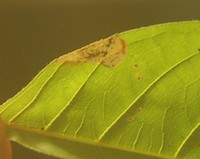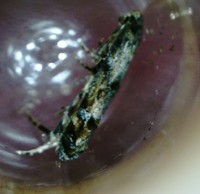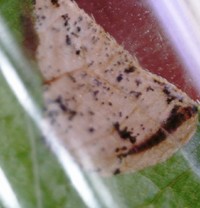Taxonomy
Superfamily:
Family: Subfamily: P3 Number: MONA Number: MONA Synonym: Mompha cephalonthiella
Comments: The genus Mompha consists of around 46 described species in North America. In addition, numerous species remain to be described that are centered in the southwestern US (Bruzzese et al., 2019). The adults are small moths that have two or more tufts of raised scales on each forewing. The larvae either mine leaves, or bore into the stems, flower buds, flowers, or fruits of their hosts. The majority of species feed on members of the Onagraceae, but others feed on species in the Cistaceae, Lythraceae, Melastomataceae, and Rubiaceae.
Identification
Adult Markings: The following description is based on accounts by Chambers (1871) and Wagner et al. (2004). The frons is shiny white and the labial palp grayish above. The antenna is annulated with pale and dark brown rings on the lower three-fourths. The distal fourth has four or five narrow white rings that are widely separated by black segments. At the very tip, there are one or two white flagellomeres that are preceded by five dark flagellomeres. The ground color of the thorax and forewing is dark bluish gray and flecked with whitish scales. The forewing is irregularly spotted with velvety black, and there is often an ocherous patch near the base of the wing and near the disc. There are scale tufts at one-third and three-fourths the wing length. The basal scale tuft is blackish, while the outer tuft is ochreous and margined in black. The costa usually has three dark brown stigulae that are evident at about one-third, two-thirds, and three-fourths. There is an acutely angled indistinct dark patch with a band of grayish white scales on the apical end of the wing. A dark marginal line is present at the base of the cilia. The hindwing is uniformly grayish and the legs have dark banding. Mompha cephalonthiella varies in patterning and coloration (often influenced by light conditions), and generally resembles M. solomoni . This species lacks the conspicuous, elongated, black dash in the discal area of the forewing that is joined with a white dash, as seen in M. solomoni . In addition, M. cephalanthiella has one or two white flagellomeres on the antenna tip that are preceded by five dark flagellomeres. In M. solomoni , the five dark flagellomeres are interrupted by a pale ring. Wagner et al. (2004) provide additional characters that are helpful in distinguishing these species from one another.
Adult Structural Features: Wagner et al. (2004) provide detailed descriptions and illustrations of the male and female genitalia of M. solomoni , along with illustrations of the genitalia of M. cephalanthiella . These closely related forms can be easily distinguished by genitalia. In male M. solomoni the anellus has distolateral, curved arms that are absent in M. cephalanthiella . The ventral margin of the valva is entire (notched in M. cephalanthiella ), and the sacculus is narrow and acuminate (wide and erose in M. cephalanthiella ). In female M. solomoni , the invaginated pockets at the posterolateral corners of tergum VII are much less prominent than in M. cephalanthiella . In M. solomoni , the posterior projections of the lamella postvaginalis are subtriangular, separated by a deep. V-shaped cleft, and preceded by a short, spinose thickening located medially at the anterior end of the cleft (projections rounded, separated by a shallow cleft, and preceded by a long, sclerotinized thickening at the anterior end of cleft in M. cephalanthiella ). Furthermore, both of the sclerotized plates associated with the signa are small and crescent shaped in M. solomoni (one or both of the plates are large and round and completely surround the signum in M. cephalanthiella ). Finally, a lamella antevaginalis is present in M. solomoni , but absent in M. cephalanthiella .
Adult ID Requirements: Identifiable from photos showing hindwings, abdomen, or other specialized views [e.g., frons, palps, antennae, undersides].
Immatures and Development: The natural history of the larval stage is poorly documented. The larvae mine the leaves of Buttonbush and produce full-depth blotch mines. These are typically formed along a leaf margin and vary from about 6-12 x 12-16 mm (Wagner et al., 2004; Eiseman, 2019). The mines are mostly free of frass, but usually have some scattered dark frass pellets.

 »
»


